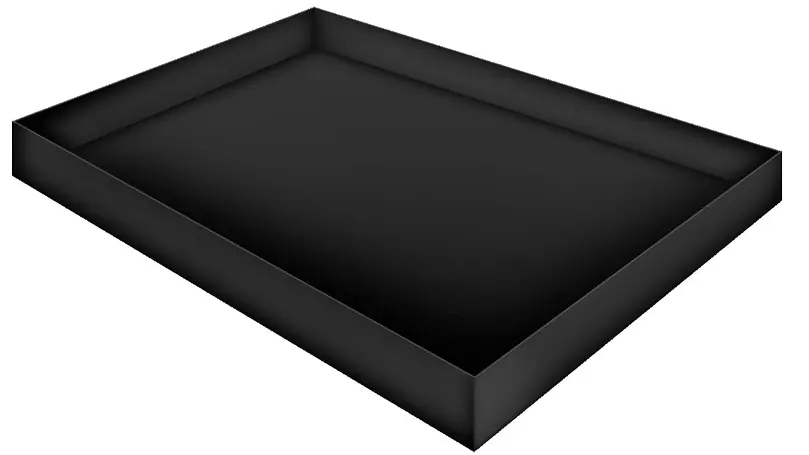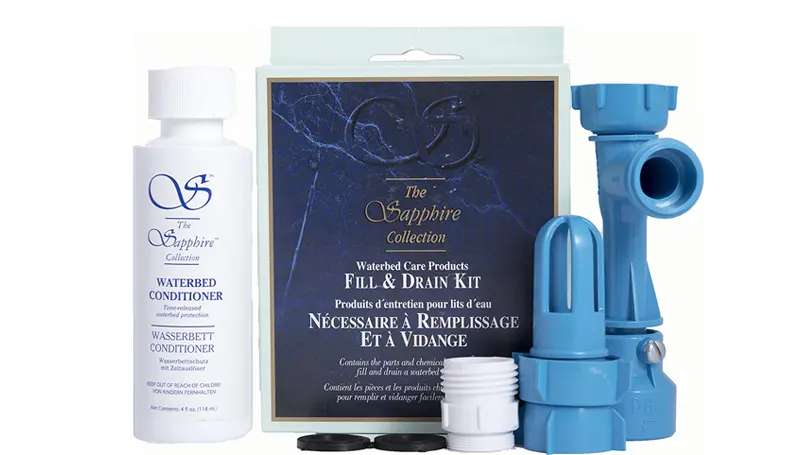What is a waterbed mattress?

On the most basic level, a waterbed mattress (or a water mattress) is a vinyl mattress filled with water. They either have one big bag or a group of smaller tubes running through the mattress that gives it form.
Over the years, different manufacturers have created their own twist on the concept, with different types of waterbeds, different accessories, and price points. We'll go through all these categories shortly, so you can decide which kind catches your eye.
What are the different types of waterbeds?
As mentioned previously, waterbed mattresses come in all shapes and sizes. But on the most fundamental level, they can be divided into two distinct groups depending on what type of waterbed frames they come with:
Hardside
Hardside waterbed mattresses represent the original design, but they can be quite a hassle. For one, they come with an external wooden frame. That means that they're quite heavy, so the movement of the bed is very limited when you're redecorating.
On top of that, a hardside waterbed mattress doesn't always come in a standardized mattress sizes, meaning that you'll probably have to go shopping for new covers as well.
Lastly, hardside waterbed mattresses live up to their name and often come with no padding on the top, just a fabric put over the vinyl. So, don't expect them to be as soft as their modern counterpart.
If nothing else, hardside waterbed mattresses tend to be a lot cheaper than softside mattresses. So, if you want a waterbed for the bedroom but don't feel like paying the premium price, they're your best bet.
Softside
Softside waterbeds are a relatively modern approach that does away with some of the faults of its predecessors. So, what happened to waterbeds? Most importantly, softside waterbeds can now hold their form via foam bolsters wrapped in a casing. This means that they're a lot easier to fit into any standard bed frame.
Plus, softside mattresses usually come with foam padding on the top, making them more comfortable and easier to get used to.
However, it's also important to note that softside waterbeds cost significantly more than the earlier models. So, you might want to look into the prices for your respective country and seeing whether there are any discount codes available before deciding whether a softside waterbed is for you.
What are the advantages of waterbeds?
Although it might've seemed like we were overly critical of waterbeds up to now, they are viable candidates for any bedroom. Here are the advantages waterbeds have when compared to traditional mattresses:
- One of the best options for reducing neck and back pain
- Temperature control options for higher-end models
- Easy to keep clean
- Typically last longer than standard mattresses.
How do I maintain my waterbed?
Although waterbeds are easy to keep clean, actual maintenance is an entirely different story. Here are the steps you'd need to take in order to keep your mattress up to code.
- Refilling up the waterbed – this can require up to 200+ gallons of water (if it's a king-size waterbed for example) and considering the weight of the mattress, it will require getting a garden hose into your bedroom
- Adding waterbed conditioner annually – this is to stop bacteria from forming on the inner side of the vinyl
- Stopping any leaks – getting a leak is a nightmare for any waterbed owner but it can be fixed. Just use the liquid cement from your vinyl repair kit in order to seal the hole up. This is also why you'd want to immediately check the mattress for any damage the second they deliver it
- Draining the mattress – if you ever want to move the waterbed, you'll have to completely or at least partly drain it first. Given the large amounts of water needed to fill one up, this can take a bit of time.
How often should I change the water in my waterbed?

Generally, you won't have to change the water in a waterbed at any point. As long as you use the waterbed conditioner annually, everything should be fine.
You might have to add a bit of water from time to time, as the mattress can get a bit deflated by pushing out moisture – but this is usually rather insignificant. Unlike a traditional old mattress, waterbeds don't start sagging but rather start leaking.
But if you happen to get a leak or want to move the bed to a different location, you might have to empty it and then refill the entire mattress.
Are waterbeds comfortable to sleep on?
Comfort is probably the biggest reason a customer might want to purchase a waterbed mattress. Just like how a memory foam mattress adapts to your body while you're sleeping, waterbeds are constantly moulding to best suit your sleeping position.
And if you go for a higher-end model, you'll have access to temperature regulation as well, which is a feature not many traditional mattresses can boast about. And that's not all.
For example, if you opt for one of the aquaglow waterbeds, not only will your get temperature control for either side of the mattress, but they also come with lumbar support and reinforced corners. Sure, you might have to pay a premium price, but we'd say you're also getting a premium experience.
So, to the question “are waterbeds comfortable”, we'd be obliged to say yes, as long as you're willing to pay for a more modern model.
Do waterbeds get moldy?
The presence of a large body of water will always have homeowners worried about mould. However, it's very easy to avoid.
Firstly, make sure to use the conditioner that comes with the waterbed in order to ensure that no mould develops within the mattress itself. Once that's out of the way, all you have to do is keep an eye out for any leaks.
So, even a lower-quality waterbed isn't as prone to mould issues as one might originally think. As long as you keep a watchful eye, you shouldn't have any issues.
Are waterbeds healthy to sleep on?
You might wonder “are water beds good for your back?”, as you might've heard something along those lines at some point. Well, waterbeds were initially used in hospitals because of the pain relief they offer – so they are very good for your back. And even today, they're an excellent choice for bedridden or paralyzed individuals as they will lessen the strain on your body during the night.
Overall, if you're having issues with neck or back pain, a waterbed might be worth purchasing as it can adapt to the shape of your body and offer much-needed relief.
Do waterbeds come with weight limits?
Although very few waterbeds come with a direct weight limit, it's an important thing to know for customers. In general, you do want to keep in mind how many people a mattress was designed for (usually listed in the details or even the name itself) and avoid any unnecessary added weight.
So, always search for these details when buying online or try asking the workers before you checkout. But as a reference point, the Afloat Essential waterbed has an upper limit of 300 pounds – which should be somewhat standard for a single-person waterbed.
How long do waterbeds last on average?

A feature that makes waterbed mattresses very tempting is that they last significantly longer than a standard mattress. While most traditional mattresses last on average between 7 and 10 years, waterbeds can hold out for anywhere between 10 and 15 years.
Not only is this very convenient, but it also makes their price a bit more appealing, as you won't have to replace them as frequently.
Are waterbeds worth the money?
At this point you might be thinking “can you still buy a water bed?” and if so, what's the average water bed price? Well, worry not, water beds are still relatively easy to get, with sellers from all over the world having their own take on the matter.
As far as price is concerned, it heavily depends. While most hardside water mattresses go between 50$ and 300$, modern softside models can cost you up to 1000$ and more. So, looking out for “water bed for sale” might be a decent strategy going forward.
Of course, high-end mattresses are just as expensive. However, with water mattresses, we personally feel like you need to opt for the higher-end models in order to properly enjoy sleeping.
Conclusion
And that's all you need to know! So, are you going to get a waterbed mattress for yourself? Why or why not? Let us know in the comments. And if you have any questions, feel free to get in touch in ask us directly.















There are no comments yet
"*" indicates required fields